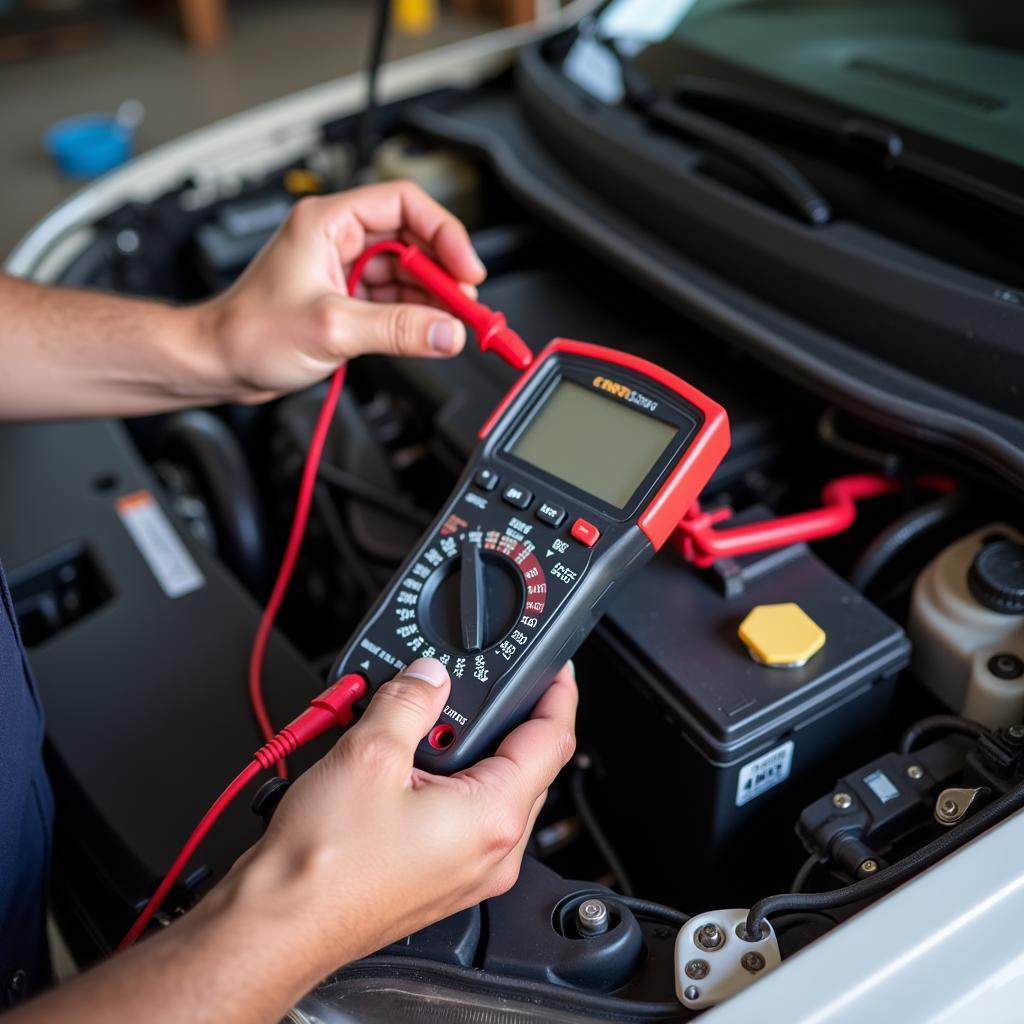VCDS battery voltage readings are crucial for accurate diagnostics and smooth operation during vehicle scans. A low or fluctuating battery voltage can lead to communication errors, incomplete scans, and even misdiagnosis. This article will guide you through the importance of VCDS battery voltage, common issues, and how to troubleshoot them effectively. Let’s dive into the world of VCDS and battery voltage!
The Importance of Stable VCDS Battery Voltage
Maintaining a stable VCDS battery voltage is paramount for reliable vehicle diagnostics. Think of it like the foundation of a house – if it’s unstable, everything else built on top will be compromised. Using a VCDS interface with a weak battery can lead to intermittent communication problems between the interface and the car’s control modules. This can result in incomplete scans, fault codes that aren’t genuinely present, or difficulty accessing specific control modules. Maintaining a healthy battery ensures accurate readings and prevents diagnostic headaches. Ensuring the battery is fully charged or using a battery maintainer while using VCDS is essential for optimal results. After all, accurate data is the key to efficient and effective vehicle repairs. More than that, a stable voltage ensures coding and adaptation procedures are completed without interruption, preventing potential software corruption.
Maintaining a steady VCDS battery voltage is also crucial when performing coding and adaptations. These procedures require a stable power supply to prevent errors or even damage to the control modules. A drop in voltage during a coding session can lead to incomplete or corrupted data, potentially rendering the module unusable. Imagine trying to upload a software update to your phone and the battery dying halfway – the consequences could be disastrous. Similarly, a stable battery voltage is essential for completing VCDS procedures successfully.
Common Issues Related to VCDS Battery Voltage
Several issues can arise due to inadequate VCDS battery voltage. One of the most common is the dreaded “01826 – Supply Voltage Terminal 30” fault code. This indicates a problem with the vehicle’s main power supply, often caused by a failing battery or alternator. You can learn more about this specific fault code in our dedicated article: 01826 vcds supply voltage terminal 30. Another frequent problem is difficulty establishing communication with certain control modules. This can be particularly frustrating when trying to diagnose a specific issue. Furthermore, low voltage can cause the VCDS software to freeze or crash, interrupting the diagnostic process and potentially leading to lost data. Low voltage situations can also trigger spurious fault codes, sending you on a wild goose chase to find non-existent problems. Identifying the root cause of these voltage-related issues is essential for accurate diagnosis and effective repairs.
Troubleshooting VCDS Battery Voltage Problems
Troubleshooting VCDS battery voltage problems can sometimes feel like detective work. The first step is to check the obvious – the battery itself. Use a multimeter to verify the battery voltage. A fully charged battery should read around 12.6 volts. If the voltage is significantly lower, the battery may need replacing. You can find helpful resources about VCDS battery issues on our site: battery vcds. If the battery checks out, the next suspect is the alternator. A faulty alternator won’t charge the battery properly, leading to low voltage during vehicle operation. A simple test can be performed to check the alternator’s output while the engine is running. Lastly, check for any parasitic drains that might be slowly depleting the battery even when the vehicle is off. These drains can be caused by faulty wiring, malfunctioning components, or even aftermarket accessories.
How do I check my VCDS battery voltage?
You can check your VCDS battery voltage directly within the VCDS software. The voltage is usually displayed prominently on the main screen.
What should I do if my VCDS battery voltage is low?
If your VCDS battery voltage is low, the first step is to charge the vehicle’s battery or connect a battery maintainer. This will ensure stable communication during the diagnostic session. Another useful resource you might find helpful is: 00985 vcds.
Can a low VCDS battery voltage cause fault codes?
Yes, a low VCDS battery voltage can trigger spurious fault codes, particularly those related to power supply issues. You may even find some overlap with information found in this article: 01m reset trans vcds.
 Mechanic Checking Car Battery With Multimeter
Mechanic Checking Car Battery With Multimeter
Conclusion
Understanding and managing VCDS battery voltage is critical for accurate diagnostics and successful coding and adaptation procedures. By addressing voltage-related issues promptly, you can ensure reliable scans, prevent misdiagnosis, and protect your vehicle’s control modules. Remember, a stable VCDS battery voltage is the foundation for effective vehicle diagnostics and maintenance. Don’t overlook this essential aspect of your VCDS workflow. If you are experiencing voltage related issues, refer to our guide on 02564 vcds.
FAQ
- What is the ideal VCDS battery voltage during a scan?
- How can I prevent VCDS battery voltage problems?
- What are the most common symptoms of low VCDS battery voltage?
- Can I use a jump starter while using VCDS?
- How can I check the health of my car’s battery?
- What should I do if my VCDS software keeps crashing?
- Is it safe to perform coding with a low battery voltage?
Common Situations and Questions
- My VCDS scan keeps interrupting. This could be due to low battery voltage.
- I’m getting strange fault codes that don’t seem related to the actual problem. Low voltage can trigger spurious fault codes.
- My car battery keeps dying. This could indicate a parasitic drain or a failing alternator.
Related Articles and Further Reading
For more information on related topics, please check out these resources: “Understanding VCDS Error Codes” and “Battery Maintenance Best Practices.”
Need Help? Contact Us!
For assistance with your automotive diagnostic needs, contact us via Whatsapp: +1 (641) 206-8880, Email: [email protected] or visit us at 276 Reock St, City of Orange, NJ 07050, United States. Our customer service team is available 24/7.



